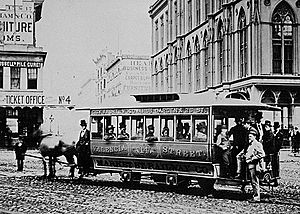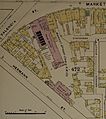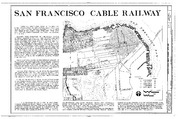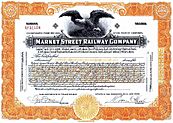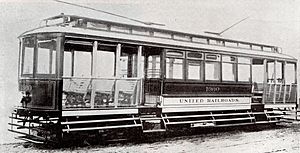Market Street Railway (transit operator) facts for kids
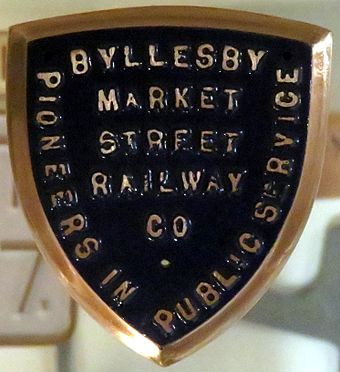
Market Street Railway brass logo.
|
|
| Overview | |
|---|---|
| Locale | San Francisco, California |
| Dates of operation | 1857–1944 |
| Successor | San Francisco Municipal Railway |
| Technical | |
| Length | 284 miles (457 km) (in 1929) |
The Market Street Railway Company was a big company that ran streetcars (also called trolleys) and buses in San Francisco. It was named after the famous Market Street in the city, which was a main part of its transport system.
Over the years, the company had a few different names. These included the Market Street Railroad Company, the Market Street Cable Railway Company, and the United Railroads of San Francisco. It was once the largest public transport company in San Francisco. In 1944, the company closed down. Its vehicles and services were bought by the city-owned San Francisco Municipal Railway, often called Muni. Many of the old routes still exist today, but they are now served by buses.
It's important not to confuse this old company with the current Market Street Railway. The new one is a non-profit group that helps support San Francisco's historic streetcar lines. It is not connected to the original company.
Contents
History of San Francisco's Streetcars
Early Days: Horse and Steam Power
The idea for what became the Market Street Railway started in 1857. The first line opened on July 4, 1860. It was called the Market Street Railroad Company. At first, it used horsecars, which were carts pulled by horses. This was the first horsecar line in San Francisco.
A few years later, the company changed to using steam power. They used small steam locomotives, called "steam dummies," to pull passenger cars. These locomotives were built in San Francisco. Some were 24 feet long and pulled 40-foot trailers. These trailers could seat 64 passengers.
By 1895, the company was selling its old horse cars. Some of these old streetcars were used to build a unique community. It was called Carville-by-the-Sea, where people lived in old streetcars!
The Cable Car Era
After the first cable car line opened in San Francisco in 1873, people wanted more. In 1882, a businessman named Leland Stanford bought the Market Street Railroad Company. He changed its lines to use cable cars. The company's name became the Market Street Cable Railway Company (MSCRy).
This company grew to be the biggest cable car operator in San Francisco. At its busiest, it ran five lines. All these lines met on Market Street and ended at the Ferry Building. During busy times, a cable car left the Ferry Building every 15 seconds!
Electric Streetcars and United Railroads
Technology kept changing. New electric streetcars were cheaper to build and run than cable cars. They could also climb most of San Francisco's hills. In 1893, Leland Stanford passed away. The Southern Pacific Railroad took over the company.
The company was renamed the Market Street Railway Company again. It started changing its lines to use electric power. In 1895, they even opened a special line called the Fillmore Counterbalance. It was a mix of a funicular (a type of railway that uses cables to pull cars up steep slopes) and an electric streetcar.
In 1902, the Southern Pacific Railroad sold its San Francisco railways. A group of investors bought them and combined them with other lines. They formed a new company called the United Railroads of San Francisco (URR).
Some people didn't like the idea of electric streetcars. They thought the overhead power lines looked ugly in the city center. But on April 18, 1906, a huge earthquake hit San Francisco. This disaster changed everything. As the city rebuilt, the company was able to replace most of its cable car lines with electric streetcar lines.
After the earthquake, the city allowed United Railroads to put up overhead wires on Market Street. Some people thought the company was taking advantage of the disaster. There were also some problems with city officials and business owners during this time.
Growth and End of an Era
Over the years, the Market Street Railway (and its earlier forms) took over many smaller railway lines. But the earthquake also led to a new competitor. In 1912, the city started its own railway system, the San Francisco Municipal Railway (Muni).
By 1918, Muni was directly competing with the Market Street Railway on Market Street. Both companies had their own tracks. This led to what was called the "roar of the four." The Market Street Railway tracks were on the inside, and Muni's tracks were on the outside.
Competition and some worker issues led to the United Railroads changing its name back to the Market Street Railway Company. It kept running electric streetcars, the Powell Street cable car lines, and a growing number of buses.
However, the company had difficulties with the city. On May 16, 1944, voters decided to buy the Market Street Railway's operations for $7.5 million. The company then sold all its vehicles and services to Muni. This marked the end of the Market Street Railway Company.
Surviving Vehicles
Some vehicles from the old Market Street Railway fleet still exist today!
Passenger Cars
- Car 578 was built in 1896. It's a special type of streetcar called a California car. It has open sections at the ends and a closed part in the middle. After being used as a work car for many years, Muni restored it. It still runs for special events and tours.
- Car 798 was built by the company in 1924. It was sold for scrap after World War II. But it was later used as a home and a jewelry store in a town called Columbia, California! It was bought back in 1984 and is being restored. It might be used on the F Market line sometimes.
- Car 755 was built in 1895 and is like car 578. It was sold to another railway and then acquired by Muni in 1913. It ran as a passenger car until 1922, then became a work car. It was retired in 1946 and is now waiting to be restored at the Western Railway Museum.
- Car 974 was built by the company itself. It was acquired by a railway association but sadly burned in storage before the Western Railway Museum was formed.
- Parlor car "San Francisco" was built in 1901. It was a fancy car that people could rent for special trips. Later, it became a "school car" that took students around the city for free. After World War II, it was sold and became a hot dog stand! It was later saved and is now at the Western Railway Museum.
Maintenance Equipment
- Car 0109 started as a passenger streetcar in 1891. It was later rebuilt into a side dump car (for carrying materials) and then a rail grinder (to smooth the tracks). Muni took it over in 1944. It is now at the Western Railway Museum.
- Car 0130 was built as an electric crane in 1904. It was used by the Market Street Railway and then by Muni. It is now at the Western Railway Museum.
- Car 0304 was built in 1900 as a passenger car. It was later rebuilt into a wrecker (for clearing accidents) and then a car for maintaining overhead power lines. It is still owned by Muni today.
Former Routes
The Market Street Railway had many different routes for its streetcars and buses. The last streetcar routes were stopped or changed to bus or trolleybus lines by 1949. Two of the old cable car lines became part of the current San Francisco cable car system.
Here is a list of some of the routes the company operated:
| xx | Line acquired by Muni in 1944 |
| No. | Name | Service type (1943) | Notes |
|---|---|---|---|
| 1 | Sutter and California | Streetcar | Streetcar service ended in 1949 under Muni. |
| 2 | Sutter and Clement | Streetcar | Streetcar service ended in 1949 under Muni. |
| 3 | Sutter and Jackson | Streetcar | Streetcar service ended in 1949 under Muni; became a trolleybus line. |
| 4 | Sutter and Sacramento | Streetcar, motor coach | Streetcar service ended in 1948 under Muni. |
| 5 | McAllister | Streetcar | Streetcar service ended in 1948 under Muni; became a trolleybus line. |
| 6 | Haight and Masonic | Streetcar | Streetcar service ended in 1948 under Muni; became a trolleybus line. |
| 7 | Haight and Ocean | Streetcar | Streetcar service ended in 1948 under Muni. |
| 8 | Market and Castro | Streetcar | Streetcar service ended in 1949 under Muni. The route was brought back as the F Market historic streetcar line in 1995. |
| 9 | Valencia Street | Streetcar | Streetcar service ended in 1949 under Muni. |
| 10 | Sunnyside | Motor coach | Streetcar service ended in 1942. |
| 11 | Mission and 24th Street | Streetcar | Streetcar service ended in 1949 under Muni. |
| 12 | Ingleside and Ocean | Motor coach | Streetcar service ended in 1945 under Muni. |
| 14 | Mission Street | Streetcar | Streetcar service ended in 1949 under Muni; became a trolleybus line. |
| 15 | Kearny and North Beach | Motor coach | Streetcar service ended in 1941. |
| 16 | 3rd and Kearny | Streetcar service ended in 1941. | |
| 17 | Haight and Ingleside | Streetcar | |
| 18 | Daly City and Cemeteries | Regular streetcar service ended in 1935. | |
| 19 | Ninth, Polk, and Larkin | Streetcar, motor coach | |
| 20 | Ellis and O'Farrel | Streetcar | |
| 21 | Hayes Street | Streetcar | Streetcar service ended in 1948 under Muni; became a trolleybus line. |
| 22 | Fillmore Street | Streetcar | Streetcar service ended in 1948 under Muni; became a trolleybus line. |
| 23 | Fillmore and Valenica | Motor coach | |
| 24 | Mission and Richmond | Motor coach | Streetcar service ended in 1935; became a trolleybus line. |
| 25 | San Bruno Avenue | Streetcar, motor coach | |
| 26 | Gurrero Street | Streetcar, motor coach | |
| 27 | Bryant Street | Motor coach | Became a bus line. |
| 28 | Harrison Street | Motor coach | Streetcar service ended in 1940. |
| 29 | Kearny and Broadway | Streetcar service ended in 1941. | |
| 30 | Army Street | Streetcar service ended in 1940. | |
| 31 | Balboa Street | Streetcar | Streetcar service ended in 1949 under Muni; became a trolleybus line. |
| 32 | Hayes and Oak | Streetcar service ended in 1932. | |
| 33 | Eighth and Park | Trolleybus | Converted to trolleybus in 1935. |
| 34 | 6th and Sansome | Streetcar service ended in 1936. | |
| 35 | Howard Street | The city stopped the company's permit for this street in 1939. | |
| 35 | 24th Street | Motor coach | |
| 36 | Folsom Street | Streetcar, motor coach | |
| 40 | San Mateo Interurban | Streetcar | An old route from the San Francisco and San Mateo Electric Railway. |
| 41 | Second and Market | ||
| 42 | First and Fifth | Streetcar service ended in 1941. | |
| 43 | Broadway and S.P. Depot | Streetcar service ended in 1941. | |
| 50 | Geneva Avenue | Motor coach | |
| 51 | Silver Avenue | Motor coach | |
| 52 | Excelsior | Motor coach | |
| 53 | Southern Heights | Motor coach | |
| 55 | Sacramento Street | Motor coach | Replaced a cable car line in 1942. |
| Bosworth Street | Streetcar service ended in 1928. | ||
| Parkside | |||
| Post and Leavenworth | Streetcar service ended in 1934. | ||
| Visitacion Valley | Streetcar service ended in 1937. | ||
| Pacific Avenue Cable | Cable service ended in 1929. | ||
| Castro Street Cable | Cable service ended in 1941. | ||
| Sacramento Clay Cable | Cable service ended in 1942, changed to a bus line. | ||
| 59 | Powell Mason Cable | Cable car | These lines became part of the San Francisco cable car system. |
| 60 | Washington Jackson Cable | Cable car | |
| Fillmore Counterbalance | Part of the 22 Fillmore route, closed in 1941. | ||
| South San Francisco |


